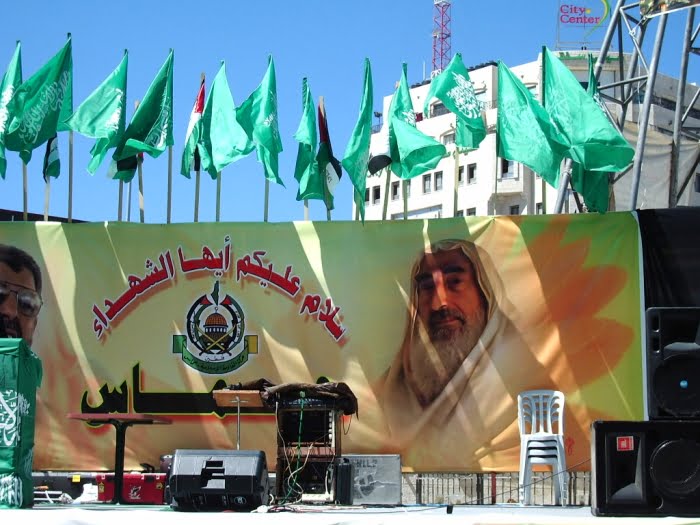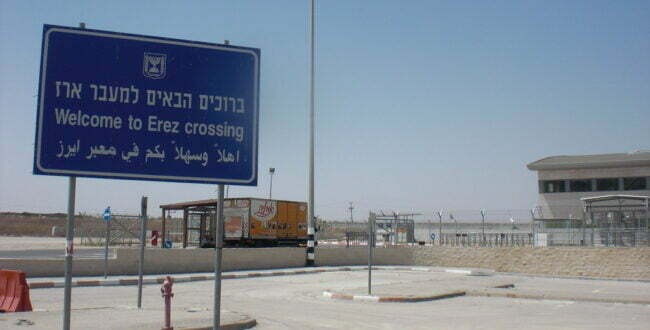Much is unknown about the internal power dynamics between the Israeli military and political establishments with regards to Gaza. Occasionally, however, a statement made by officials or a document made public shed light on the tension between the largely pragmatic approach of the security establishment and the hawkish approach of the Netanyahu government.
In October 2017, the IDF’s journal “Maarachot” published an extraordinary article. The article caused a stir in the public debate concerning Gaza, not just because of its content – which was worded carefully – but mainly due to its authors: the Coordinator of Government Activities in the Territories, Major General Yoav (Poli) Mordechai, and his Adviser on Palestinian Affairs, Colonel Michael Milstein.
In the article, entitled “Six Divisions or Two Million People? How Operation ‘Protective Edge’ Changed Israel’s View of the Gaza Strip,” Mordechai and Milstein discussed the conflict between Israel and Hamas in the summer of 2014, which cost the lives of over 2,100 Palestinians and 73 Israelis. The authors described the conflict not as a “result of planning, preparation and set intentions by both sides, but a degeneration into large-scale conflict, which none of the sides were prepared for or wanted.” As in World War I, they wrote: “the two sides found themselves in a faceoff… stemming, at its core, from miscalculation and lack of mutual strategic clarity.”
As far as Hamas was concerned, the reason the campaign lasted 50 days was the desire to wrest political concessions related to civilians’ freedom of movement and improvements to Gaza’s infrastructure, wrote Mordechai and Milstein. Hamas remains determined to preserve its political rule over the Gaza Strip and fought ferociously to preserve its position and channel internal agitation toward confrontation with Israel. Therefore, it was not religious ideology that drove it to attack Israel, but internal political and much more quotidian needs.
In the article’s conclusion, the authors pointed to two approaches emerging in Israel concerning the ongoing crisis in Gaza: On the one hand, those supportive of “reaching a strategic settlement” with Hamas, which would entail a ceasefire (“hudna” or “tahadeah”). This path would provide Israel with stability in the south, but also raise tensions with the Palestinian Authority and Egypt and allow Hamas to further entrench its grip over the Gaza Strip. On the other hand, there are those who support increased involvement of the Palestinian Authority in the Strip – reinstating its control over border crossings, its presence in the border area, and control over civilian institutions (infrastructure and governmental offices unrelated to matters of security). This second alternative – which the authors doubted is even implementable – could potentially create, through a gradual process, an alternative to Hamas’ rule. It is worth noting that the authors plainly disregarded a third alternative, which is quite popular in Israeli political discourse, and can be concisely described as “toppling Hamas rule.”
Prior to assuming his position as minister of defense in April 2015, Avigdor Liberman vowed that when he takes over this role, the next campaign against Hamas “will be the last.” A day before the 2015 elections, during a visit to Nativ Haasara, a village neighboring the Gaza Strip, Liberman lambasted Prime Minister Netanyahu’s non-confrontational approach toward Hamas. “Eliminating the rule of Hamas is the most important task of the government of Israel and as minister of defense, I will do this. We will not reach agreements and understandings with them. The only agreement that can be reached with Hamas is when they are buried under ground,” he insisted.
Naftali Bennet, the former Minister of Education and member of the political-security cabinet of the previous government, made similar statements. In a speech delivered during the inauguration of a medical school at the Ariel University, Bennet compared Hamas’ demand to receive salaries for its civil servants in exchange for quiet along the border to blackmail attempts of the Italian Mafia: “those who surrender to protection rackets, will bring war upon us. Israel must not surrender to Hamas’ protection threats.” He added, however, that the military action he recommends does not necessarily entail a ground incursion into Gaza. Back in 2014, during Operation Protective Edge, Bennet stated that toppling Hamas’ rule is an option on the table, as far as he is concerned, but did not offer an alternative to the organization’s rule in Gaza.
The bluster coming from ministers Liberman and Bennet was politically costly and proved that the Israeli public cares a great deal about the proper solution to “the Gaza problem.” In his resignation speech in November 2018, Liberman explained that he could not deliver on his election promises, chief among them the toppling of Hamas rule, and the assassination of Hamas leaders within 48 hours of assuming his position. Liberman also lambasted the government for allowing the transfer of Qatari funds to Hamas. “Everyone knew my positions when I entered the government, but it is unreasonable to prevent any offensive operations in Gaza and the next day ask why 48 hours have passed and Haniyeh is still alive,” he said.
The day following Liberman’s resignation, Bennet demanded to receive the position of minister of defense as a conditioning for remaining in the government, to “make Israel win again.” “For dozens of years now, our systems have adopted a mental fixation of avoiding military confrontation with the enemy. An approach of disengagement. The enemy reads us and interprets it as fear of combat. The most dangerous thing for Israel is that we start thinking that there is no solution for terrorism, terrorists and missiles,” said Bennet. “We have an excellent military, dedicated commanders and a top-notch general staff. At the same time, the role of the minister of defense is to challenge thinking, bring innovations, engender creative and surprising alternatives [to the ones proposed by the military establishment] … The role of the minister of defense is to initiate and lead policy, and not to be led.” Two days later, Bennet dropped his demand and remained in the government.
In March 2019, as the election campaign intensified, Bennet clarified who, in his view, leads Israel’s feeble policy toward Hamas: the senior command of the IDF, which restricts the freedom of operation of the fighters and commanders in the field. In a series of tweets, Bennet excoriated Benny Gantz, the Chief of Staff during Operation Protective Edge and his political rival, labeling him “the wet dream of Hamas,” and “the general of indecisiveness.” Outside of the political arena there were some who berated the IDF for its unwillingness to defeat Hamas. In an article published on the conservative website Mida, Dan Sion, a retired lieutenant colonel and former squadron commander, criticized the leak – in the midst of Operation Protective Edge – of a secret presentation created by the IDF, which included and assessment that clearing Gaza of offensive weaponry would take five years, would entail the death of thousands of Palestinians, and cost the Israeli economy ten billion NIS ($2.78 billion).
“Is the IDF incapable of defeating Hamas in the Gaza Strip (with a reasonable cost) as presented, or is it disinterested in doing so?” Asked Sion in the article, and determined that the latter option is correct. “Since the 1990s, the IDF adopted characteristics of a ‘post-modern military’ that is fearful of incurring casualties, and prefers technological solutions and standoff weaponry over initiating face-to-face contact with the enemy’s soldiers. The IDF is affected by civil society organizations and adapts itself to the media discourse of social elites. The IDF prefers ‘managing conflicts’ to ending them, and is willing to settle for ‘an image of victory’ rather than actual victory.”
Contrary to Sion’s argument, the pragmatic approach toward Hamas it not a result of post-modernist pressures exerted on the military from civil society organization. This approach originates from the heart of the military establishment. In a May 2018 interview with IDF Radio, the former Head of the Shin Bet, Yoram Cohen, stated that it is not Islamist messianism that drives Hamas’ calculations, but the organizations desire to “be a state like all other states, and be a people like all other people.” Instead of toppling Hamas rule, the former Shin Ben head recommending improving the economic conditions in the Gaza Strip.
Yuval Diskin, Cohen’s predecessor, made similar statements to residents of Israeli villages surrounding Gaza, several months after the 2014 conflict. “We need the economic situation in Gaza to improve,” said Diskin to residents of Beeri, a kibbutz near Gaza, in November 2014. “We need to ensure that they are not using materials entering for the purpose of [manufacturing] weaponry. I think that if we and the international community make sure to create economic projects in the Strip, there is a chance that Hamas will prefer that situation over military confrontation.”
Major General (retired) Giora Eiland, formerly the head of the IDF’s Planning Directorate and former head of the National Security Council, adopts the most “generous” approach toward Hamas. According to Eiland, Gaza is “a de-factor independent state for 11 years [now],” whose interests completely align with Israel’s short-term interests: avoiding a military conflagration and bringing about economic prosperity to the Strip. Eiland believes it is illogical to transfer aid funding to Gaza via the Palestinian Authority. “Israel needs to encourage Western and Arab states to invest in reconstructing Gaza, in cooperation with Hamas’ government and not behind its back,” he wrote in an article published by Yedioth Aharonot in March 2018.
In the article, Eiland argued “the more this happens — the more power stations, desalination plans, or sewage treatment projects are created – the more Hamas’ government will be restrained. I am familiar with the argument that Hamas will exploit the assistance just to build more tunnels, but I stake the opposing position: what has been happening in recent years is precisely because there are no negotiations with Hamas and Hamas is not given the money or the means directly. Hamas will invest more in civilian infrastructure if it is recognized as a de-facto state, if agreements are made with it requiting more strict monitoring over the cement and other [reconstruction] materials entering the Strip.”
According to Eiland, the political divide between Hamas and Fatah is an internal Palestinian problem that does not have a short-term solution, and this split serves Israeli interests.
A similar contestation can be observed between the military and political ranks of Hamas. For example, the Spokesman of the armed wing of Hamas, Abu Oubeida, consistently supports armed struggle and lone-wolf attacks in the West Bank and sees them as the only avenue for struggle against Israel. On the other hand, leaders from the political wing, such as Hassan Yousef and Hossam Badran, a member of Hamas’ Political Bureau (and member of the negotiating team for a settlement with Israel) , emphasize the need to pursue a political track, in line with the recognition of Israel within the 1967 borders, as it appears in Hamas’ 2017 Updated charter.
Israel’s unwillingness to recognize Hamas is reminiscent of the refusal to recognize the Palestine Liberation Organization (PLO) led by Yasser Arafat prior to the early 1990s. A combination of factors eventually led Israel to alter its position and pave the way to the Oslo Accords. These factors include (in no particular order of importance):
- Contact between elements within the Israeli left and PLO representatives during the 1980s. Particularly notable meetings were conducted by Uri Avineri, (retired) Major General Mati Peled, Luba Eliav and others.
- The November 1988 decision of the Palestinian National Council (known as the Palestinian Declaration of Independence) to “move the intifada from the stage of stones, in the battlefield, to the stage of political initiative, with the Palestinian side implementing a technique of creativity and initiative.”
- A shift in the approach of the U.S. administration in December 1988, immediately following the decision of the Palestinian National Council, to launch a dialogue with the PLO. According to the analyst Moshe Shemesh, following the outbreak of the first intifada, the Americans expected that the Israeli approach will change, paving the way for dialogue with the PLO. According to him, this change was “a strategic shift in the U.S. position.” Several weeks prior, a group of American Jews met with Yasser Arafat in Stockholm, mediated by Foreign Minister Andersen.
- Change in the Israeli government following the 1992 election, when Yitzhak Rabin defeated Yitzhak Shamir based on a political platform calling for an agreement with the Palestinians.
One of the elements that allowed Israeli to recognize the PLO was the gradual change in the position of the Palestinian organization: first the decision to limit its military activities to Israel and the occupied territories (and not carry out attacks abroad), and finally, the Palestinian 1988 Declaration of Independence, which called for abandoning the armed struggle in favor of a political track. A similar change has occurred within Hamas, from a combative 1988 charter to the more conciliatory document issued in 2017. Will Israel recognize the opportunity emerging from these developments?
Doves in the Government, Hawks in the Military
Despite the aforementioned, it would be incorrect to claim a clear dichotomy between the hawkish political arena and a dovish military establishment. Within Netanyahu’s cabinet there are pragmatic voices that clearly express the futility of a military-only approach to Gaza and support a civilian approach of rehabilitating Gaza. On the other hand, there are voices within the military-security establishment that challenge the perception that it would be beneficial for Israel to bolster the independence of the Gaza Strip from Israel, arguing that Israel’s unwillingness to reconsider reoccupying Gaza emboldens Hamas.
For example, during the May 2018 military escalation between the IDF and Palestinian factions in Gaza, Minister of Transportation Israel Katz, argued that “we have no business in Gaza. Israel does not want to enter Gaza.” Katz, who had proposed a plan to reconstruct Gaza that entailed building an artificial port off of Gaza’s coast, argued that Gaza should be allowed to trade with the outside world under Israeli security oversight. “This is not a reward for Hamas,” Katz asserted, “it is a reward for Israel. I don’t want to grant Hamas control over two million people as a result of Israeli jailing them and shutting them out.” Six months later, during another conflagration between the IDF and Hamas following a botched operation of an elite IDF unit deep inside the Gaza Strip, cabinet member Yuval Steinitz argued that the government “is not interested in being dragged into an unnecessary war that has no real strategic goals, as far as Israel is concerned.” Steinitz pointed out the consensus between the political echelon and the military establishment concerning Gaza, emphasizing the devastating cost in human lives and destruction of property in Israel of an operation to occupy Gaza and topple Hamas.
On the other hand, Lieutenant General (retired) Gershon HaCohen, the former Commander of the IDF’s Military Colleges and currently a Senior Research Fellow at the Begin-Sadat Center, argued in an article published in Israel Hayom that Hamas has no interest to become more moderate as long as it knows that Israel will never act to topple it. “Israel’s need to maintain the disengagement that was achieved in Gaza is one of the elements that pushed us into a corner. This Israeli need gave rise to the perception of the futility of an attack on Gaza: why reconquer if we want to leave and disengage again?” wondered HaCohen. “Prime Minister Netanyahu, who wishes to avoid the overall framework of the two-state solution, has a clear interest in the emergence of an independent Hamas state in Gaza, and it is preferable in his view to maintain the Strip’s current rulers. Hamas’ leadership has wisely exploited this conundrum, displaying strategic prowess that should be studied.”
Israel’s political leadership is unable to decide between the two paths before it. Alongside bellicose threats of toppling Hamas and engaging in rounds of conflict with varying degrees of intensity, in January 2019 the government approved transferring millions of dollars to Hamas for payment of salaries to its civil servants and needy families. Israel continues to maintain contact with Hamas, through Qatari and Egyptian mediation, and occasionally through the Europeans, including the German and Norwegian governments. At the same time, when the Europeans engage Hamas without Israeli approval, Jerusalem reacts forcefully. For example, in November 2017, Minister of Defense Liberman barred the entry of Swiss representatives to Gaza after Swiss diplomats met with Hamas’ leadership in the Strip.
Meanwhile, the negotiations concerning a long-term agreement mediated by Egypt, are continuing regardless of the occasional escalatory rounds. Thus, only days after two rockets were fired at Tel Aviv, in an act defined by Hamas as “an error” (a claim confirmed by Israeli defense officials), Israel resumed negotiations on easing the closure of the Gaza Strip.
The Complex Approach of the International Community toward Hamas
The 2006 decision of the International Quartet (the United States, the United Nations, the European union and Russia) concerning Hamas continues to guide the approach of the international community vis-à-vis the organization. According to this decision, the Quartet will recognize and engage Hamas only if it adopts three fundamental conditions: recognition of Israel, recognition of previous accords signed between the Palestinians and Israel, and abandoning its armed struggle. As a result, the EU and most Western countries continue to list Hamas as a terror organization and avoid official engagement with the movement. Russia and China, on the other hand, do not view Hamas as a terrorist organization. Laws in Australia, New Zealand and the United Kingdom distinguish between the armed and political wings of the organization, listing only the armed wing as a terrorist group.
The hardline approach of the Quartet toward Hamas after its victory in the 2006 Palestinian parliamentary elections was not a given. James Wolfensohn, the Quartet’s Envoy to the Middle East, resigned from his position less than a year after assuming it, because he felt that the constrains placed on Hamas – and particularly the abrogation of the Crossings Agreement and confiscation of Palestinian taxes – were preventing him from properly fulfilling his role.
There are also multiple voices in U.S. and European think-tanks calling for recognition and engagement with Hamas. Back in 2006, a few months after its election victory, Henry Siegman, a researcher of Palestinian politics at the prominent American think-tank Council on Foreign Relations, detected signs of moderation in Hamas’ leadership (particularly due to its decision to halt financing of suicide bombings), and called on Israel and the United States to engage with the organization. His research quoted former Mossad chief, Efraim Halevy, who called for combating Hamas’ terrorism while at the same time allowing it to become incorporated into the Palestinian political system.
In 2010, Daniel Byman, a Senior Research Fellow at the Brookings Institution, made a similar argument. In an article published in Foreign Affairs, Byman argued that the pre-conditions set by President George Bush in 2006 for recognition of Hamas are no longer relevant. Byman wrote that the Obama administration upheld Bush’s boycott policy as a “default,” arguing that Israeli policy too “remains stuck in the past.” Byman proposed that Israel establish a more sophisticated system of “carrots and sticks” vis-à-vis Hamas, encouraging it to adopt a cooperative approach toward Israel. “Hamas is here to stay. Refusing to deal with it will only make the situation worse: Palestinian moderates will become weaker, and Hamas will grow stronger,” argued Byman. Almost a decade after Byman had made this argument, it appears that his grim prediction has come to pass.
Conclusion
There is a significant gap between the position of the security establishment and that of the Netanyahu government with regards to Hamas, despite minority views within both camps. The mainstream approach of senior IDF commanders and leaders of the Shin Bet supports a pragmatic position that ranges from reconstruction of the Strip and its economy, to official recognition of Hamas’ governance. Meanwhile, in the political arena, a growing chorus of voices sees a military solution as the only path forward. The international community’s restrictions on engagement with Hamas – although supposedly intended to serve the interests of Israel and Palestinians to advance the peace process – places Israel in a diplomatic splint that restricts its ability to display greater flexibility with regards to Hamas.
The Israeli government, for its part, tries to have it both ways: on the one hand refusing to officially recognize Hamas’ governance of the Strip, while ensuring its survival on the other. The motives for Israel’s indecision – and particularly the desire to maintain cooperation with its moderate partner in Ramallah – are understandable. And yet, Israel’s fear of taking risks that could potentially lead to a peaceful resolution, inevitably creates chronic instability and recurring rounds of conflict in the Gaza Strip.















